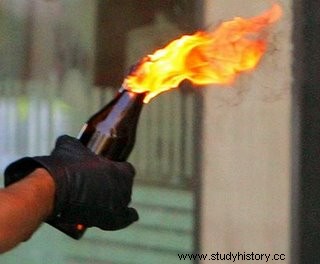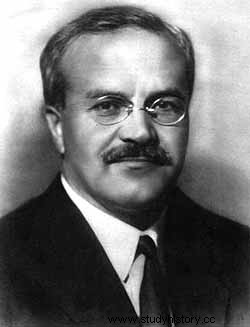The Molotov cocktail it is an incendiary bomb that in its most widespread version - lately urban - is made up of a rag or piece of cloth that, as a fuse, is placed in the mouth of a bottle with flammable products; the fabric is lit and thrown. When the glass breaks, the content spreads as it comes into contact with the flame and catches fire.

The origin of its name is due to Viacheslav Mijáilovich Skryabin -best known for Molotov , hammer -, the Soviet Foreign Minister who in 1939 signed with his German counterpart, Ribbentrop , the non-aggression pact in which Poland was divided up and kicked off the Second World War. In November 1939, the Soviets invaded Finland (Winter War) . Stalin and Molotov thought that in the face of the numerical and military superiority of the Red Army, the Finns could have little or nothing to oppose and that before the end of the year they would have conquered the entire country... big mistake, the Finnish resistance managed to hold out all winter, until March 1940 Molotov, the Joseph Goebbels The Soviet Union, a master of information/disinformation, stated in several radio announcements that the Soviets were not dropping bombs but rather food parcels for the Finnish population. The Finns, who, faced with the superiority of the Soviets, used what they could -such as incendiary bombs in bottles-, decided to respond with humor to those stupid communications:
If they provide the food, we provide the drinks (the Molotov cocktails).

Molotov
Since then, this type of incendiary bomb has been called a Molotov cocktail . But the Finns were not the first to use it... but the Spanish. Specifically, the Francoist troops against the Soviet tanks T-26 and T-28 provided to the republicans by the Soviet Union. But if we keep looking, we will find another incendiary bomb with the same characteristics used in Motril (Granada) in 1831… the Domínguez cocktail or Josef cocktail . In July 1831, this news appeared in the Madrid Gazette:
Between the waters of Calahonda and Adra [Motril beaches] the Spanish Coast Guard felucho [sailing vessel] named Josef reached a smuggler's boat. After he was close to her, he asked where it came from, he was answered by two carronades [short naval artillery piece], and following the fire from one side and the other, they managed to board. In this state, the skipper of the felucca threw several flasks of fire at the smuggler, so that his crew had to throw themselves into the sea , from where 18 men were taken, including burned and wounded. Another 8 individuals were later found aboard the smuggler's boat, in which there were 2 carronades of 12 and various contraband items. In the felucca, police lieutenant Don Manuel José Domínguez, commander of those who were in it, was seriously injured, as were the boatswain and two sailors.
